Features
Now available worldwide direct from Classic Audio Ltd. for £330/€400/$450, the SPARTAN 15 moving magnet phonostage builds on the well-received SPARTAN 10 that first put Classic Audio Ltd. on the map. The new design features the power supply used in the PRO series for higher output with all-new parts in a total re-think of the original circuit. Precision RIAA equalisation, low noise, and LF X-Feed are retained for the same immersive listening experience at an even lower price point than before.
Black and silver SPARTAN 15s
By making the most out of two gain stages through carefully gain-structuring its new NJM2068 amplifier ICs in the same manner as its predecessor, the SPARTAN 15 offers the same feature set as the former alongside some desirable new additions...
- Strict RIAA equalisation to ±0.1dB for far less colouration and channel mismatch than others at ±0.5dB
- Ultra-low distortion by splitting the final gain between two optimised amplifier stages for better linearity
- Vanishingly little background noise from dead quiet input amplifiers, specially matched to MM cartridge impedances
- LF X-Feed cancels low-frequency vertical surface noise while preserving mastered stereo separation and bass response
- 23Hz 18dB/octave subsonic filter removes surface disturbances with hand-matched capacitors to preclude tolerance effects
- Mono switching greatly reduces noise and distortion on mono and heavily worn discs for better clarity and enjoyment
- Linear split power supply with start-up mute, elevated from ±15V to ±17V for even more headroom with no switching noise
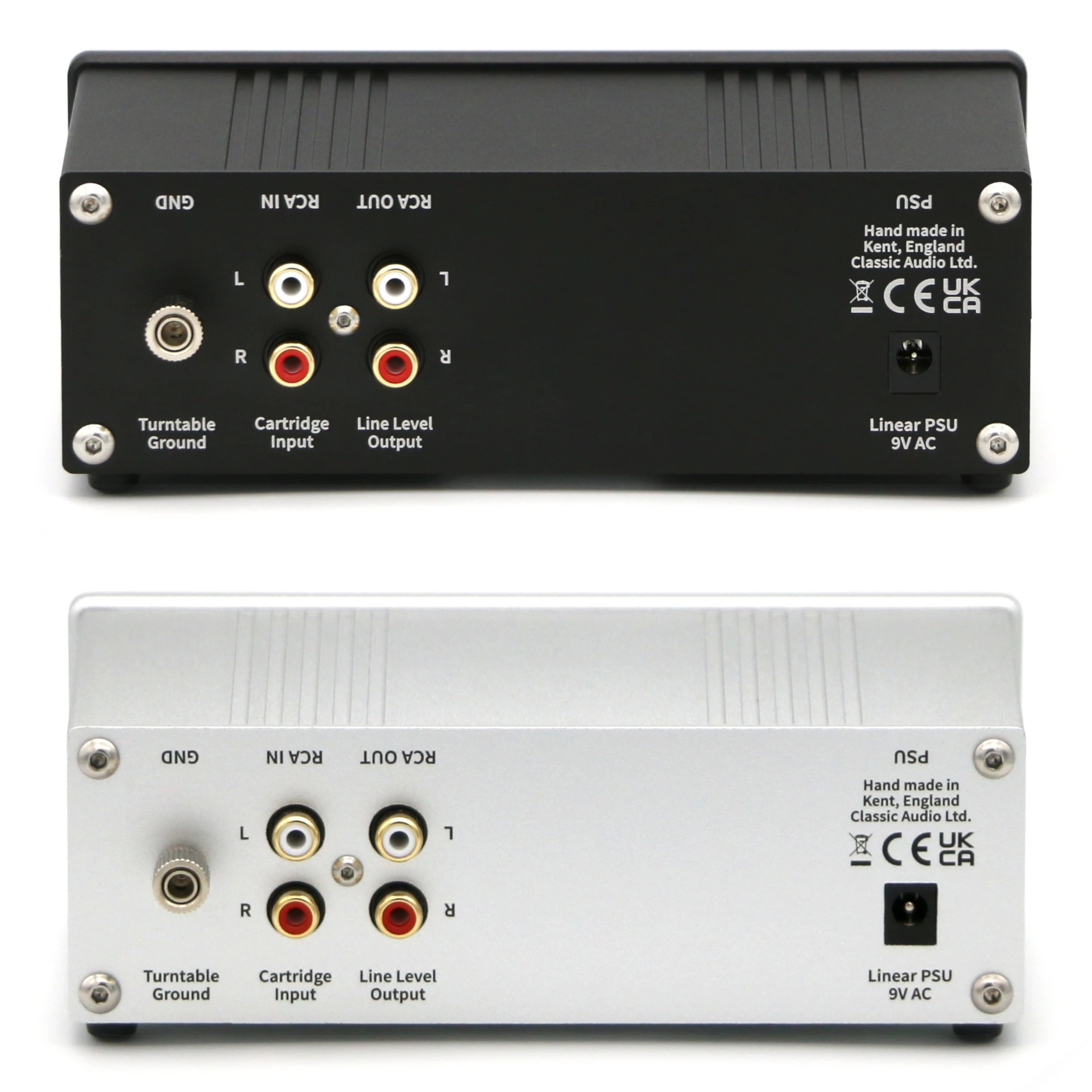
Rear panels, showing connections
Thanks to its excellent technical performance the SPARTAN 15 makes for a great upgrade over integrated and external phonostages alike costing many times more. It promises an experience that is uncoloured, revealing, and never fatiguing in any high-quality moving-magnet setup for a fraction of the cost of most 'high-end' products. It may not be a 'jack of all trades', adorned with all manner of outputs, inputs, and dubious loading options, but for a standard moving-magnet cartridge there might just be no equal for the price in terms of pure transparency and listening experience.
High-quality transfer using the SPARTAN 15
The above video from the Audiophil YouTube channel shows how the SPARTAN 15 simply gets out of the way of the music and lets the vinyl itself to shine through with an absence of unwanted artefacts, extra noise or colouration once the needle goes down. This design philosophy, aimed at focusing on moving-magnet performance for the masses, caused its forerunner to sell out the entire production run in its first year, becoming quite a cult device in the UK despite its 'journeyman' appearance!
Tilted view showing dimensions
Black and silver units are currently in stock to order in the UK for £330. Worldwide shipping for both case styles is available with GB 240V, EU 220V, and US/NEMA 120V power supplies. For more details and how to order, please see the order page.
Build quality
The SPARTAN 15 is hand-assembled in Kent, England into a compact, sandblasted, anodised aluminium enclosure which will fit easily into most setups, permitting close placement to the turntable with shorter input connections and less risk of interference. Weighing in at 650g, the thick aluminium panels give the unit a solid feel while affording full electrostatic shielding to the high-quality components inside, including:
- All through-hole technology, built by hand with 3% silver solder for extra reliability
- Fibreglass substrate double sided PCB with ground planes on both sides, minimising parasitic leakage
- Distortion-free polypropylene and polystyrene film capacitors in the equaliser and subsonic networks
- Panasonic FR series electrolytic capacitors throughout, for exceptional longevity and consistency through decades of use
- All metal thin film resistors with 1% tolerance, to obtain excellent accuracy, channel matching, and low distortion
- Classic Japanese audio amplifier ICs in turned IC sockets make replacement easy if damaged by external factors
- Gold and silver plated toggle switches for audio and power respectively, rated for 50,000 cycles
- Telecoms grade Panasonic output muting relay, for dependable silent starting for many years to come
- Gold over nickel plated RCA connectors on the rear panel, for a sound connection into the future
- Chunky nickel-plated chassis ground binding post that accepts bare wires and banana plugs
- CNC milled 6mm scratch-resistant aluminium front panel with laser-etched lettering on black enclosures
- Stainless steel hex head external screws, for an uncomplicated aesthetic
Inside the SPARTAN 15 phonostage
All the components used in the design were selected for the final result and not as marketing props, unlike many contemporary products that don't seem to deliver much in terms of overall quality. While laying out the PCB, quite a lot of time was spent minimising loop areas with the input references as close to the RCA connectors as possible, improvubg magnetic rejection. At the same time, keeping the signal path as intuitive as possible makes repair easy in the unlikely even of failure. By using readily available parts, instead of esoterica, to achieve an outstanding overall performance, the SPARTAN 15 represents great value for money and a solid investment into the future.
Specification
All of the effort that went into the design process and parts sourcing translates into an excellent specification that guarantees transparency will be maintained at this crucial point in the signal path. There are no claims of magic features here or special 'proprietary techniques' that are usually obscured or overcomplicated to hide the fact that there's no real practical benefit. Instead, the SPARTAN 15 delivers a superior set of numbers which lead to great listening and are very hard to find elsewhere...
| Parameter | Measurement | |
|---|---|---|
| Gain at 1kHz, 10kΩ line load | 40.8dB, 110x | |
| RIAA accuracy | ±0.1dB, 40Hz to 22kHz | |
| Channel balance | ±0.1dB, at 1kHz | |
| Crosstalk | <72dB 20Hz to 22kHz | |
| SNR, ref 5mV, cartridge load | 78dB, 7900x, 220Hz to 22kHz | |
| Overload margin, ref 5mV, at 1kHz | 25.5dB, 19x | |
| Maximum input at 1kHz | 94mV RMS | |
| Maximum input at 10kHz | 450mV RMS | |
| Maximum output, 3kΩ line load | 10V RMS, 20Hz to 60kHz | |
| THD, 5kΩ line load | <0.0006%, 40Hz to 22kHz, 10V RMS output | |
| Input capacitance | 120pF | |
| Input impedance | 50kΩ, ±1% | |
| Output impedance | 100Ω | |
| Minimum line load impedance | 3kΩ | |
| Subsonic filter | 22Hz, 3rd order, -20dB at 10Hz | |
| Low frequency crossfeed | 145Hz, 10dB rejection at 50Hz | |
| Power supply | Split linear ±17V | |
| Power consumption | 2W at full output, 0.2W standby | |
| Dimensions (W*H*D) | 172*60*110mm |
Starting from the top, the SPARTAN 15 will bring a 5mV cartridge output all the way up to 550mV at the line output. This is more than enough line level for any sensibly designed amplifier currently on the market and also potentially enough for many HOMC cartridges, depending on the line sensitivity of the system. The strong output level matches typical output levels of digital sources and furthermore increases the effective signal-to-noise ratio at the line amplifier's input. Tight RIAA accuracy and channel matching of ±0.1dB prevent any tonal colouration and ensure super stereo imaging. Crosstalk remains 100 times lower than any MM cartridge currently on the market.
Some of the best vinyl pressings can have a signal-to-noise ratio of 72dB (4000x), so long as it's not thrown away downstream. The phonostage should therefore have double this figure, so that electronic noise can't rise up above the groove noise and bury small details. The SPARTAN 15's SNR of 78dB (7900x) safeguards that the noise floor doesn't rise more than a decibel on very quiet pressings, resulting in a very black background that reveals even the tiniest sounds on the record.
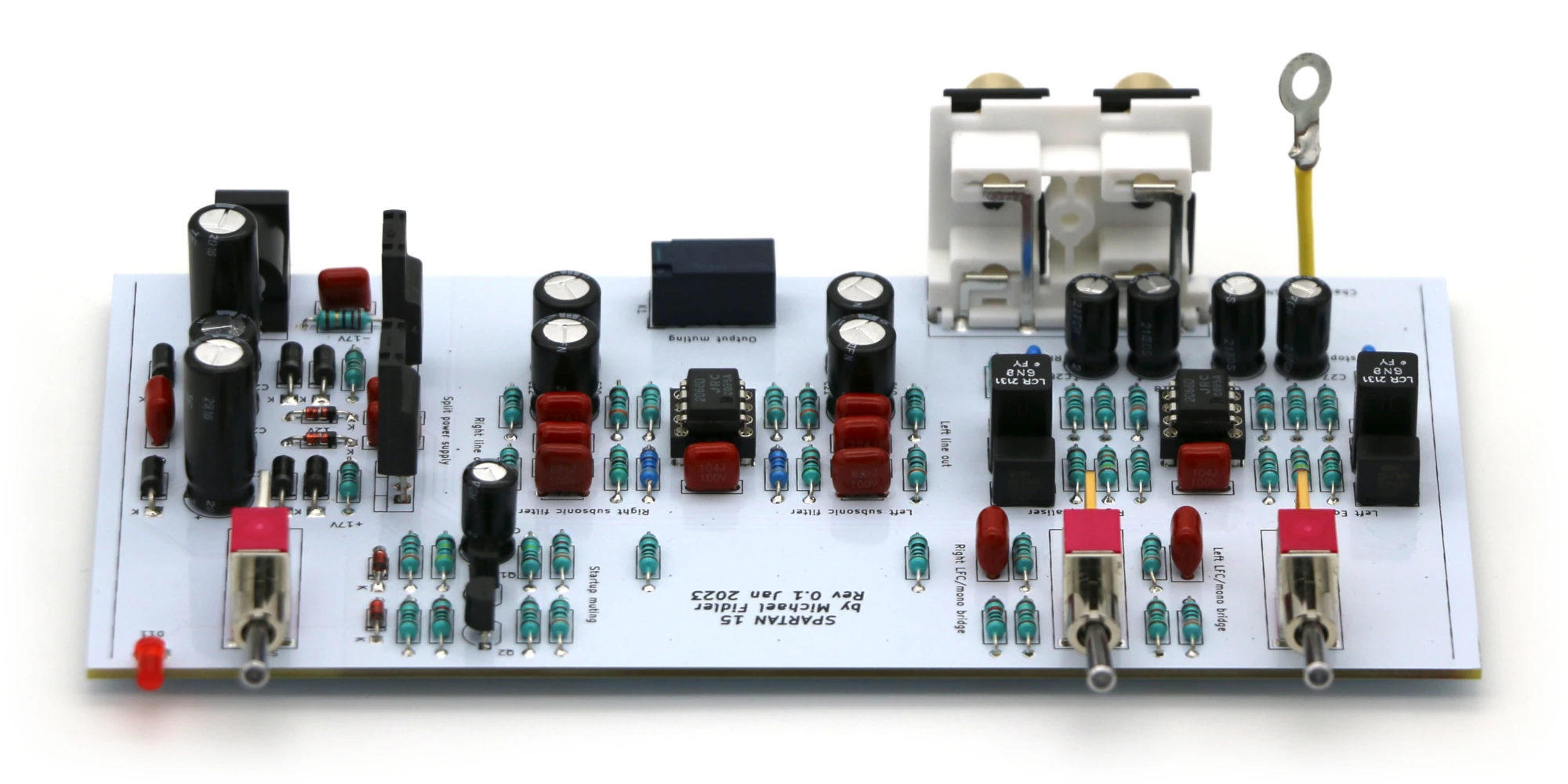
PCB with socketed low-noise 2068 amplifiers
Great dynamics require plenty of headroom. An overload margin of 25.5dB ensures that loud passages and transients never get mangled by distortion. Some of the hottest discs found in the wild require 20dB of headroom (10 times more) above the nominal cartridge output to avert clipping distortion, so the SPARTAN 15 will effortlessly handle cartridges rated up to a potent 9.5mV. Unlike passive (and many active!) RIAA designs, the input level increases with frequency up to 900mV at 20kHz, so that sharp ticks and surface defects that might be otherwise reduced by the RIAA curve can't create far more audible distortion products where hearing is more sensitive.
An abundance of headroom is very useful, but it needs to stay linear all the way up to the maximum to stop distortion from creeping into the most dynamic discs. As a result of its double-stage split gain design, the SPARTAN 15 manages 0.0006% THD (6 parts per million) at the maximum output of 10V RMS, all the way to 22kHz where everything has to work as hard as possible. This assures unmeasurable distortion at normal vinyl levels to put forward an experience unclouded by distortion products and harshness. Along with plenty of voltage, the line output has sufficient current to drive 3 standard 10kΩ inputs in parallel without complaint.
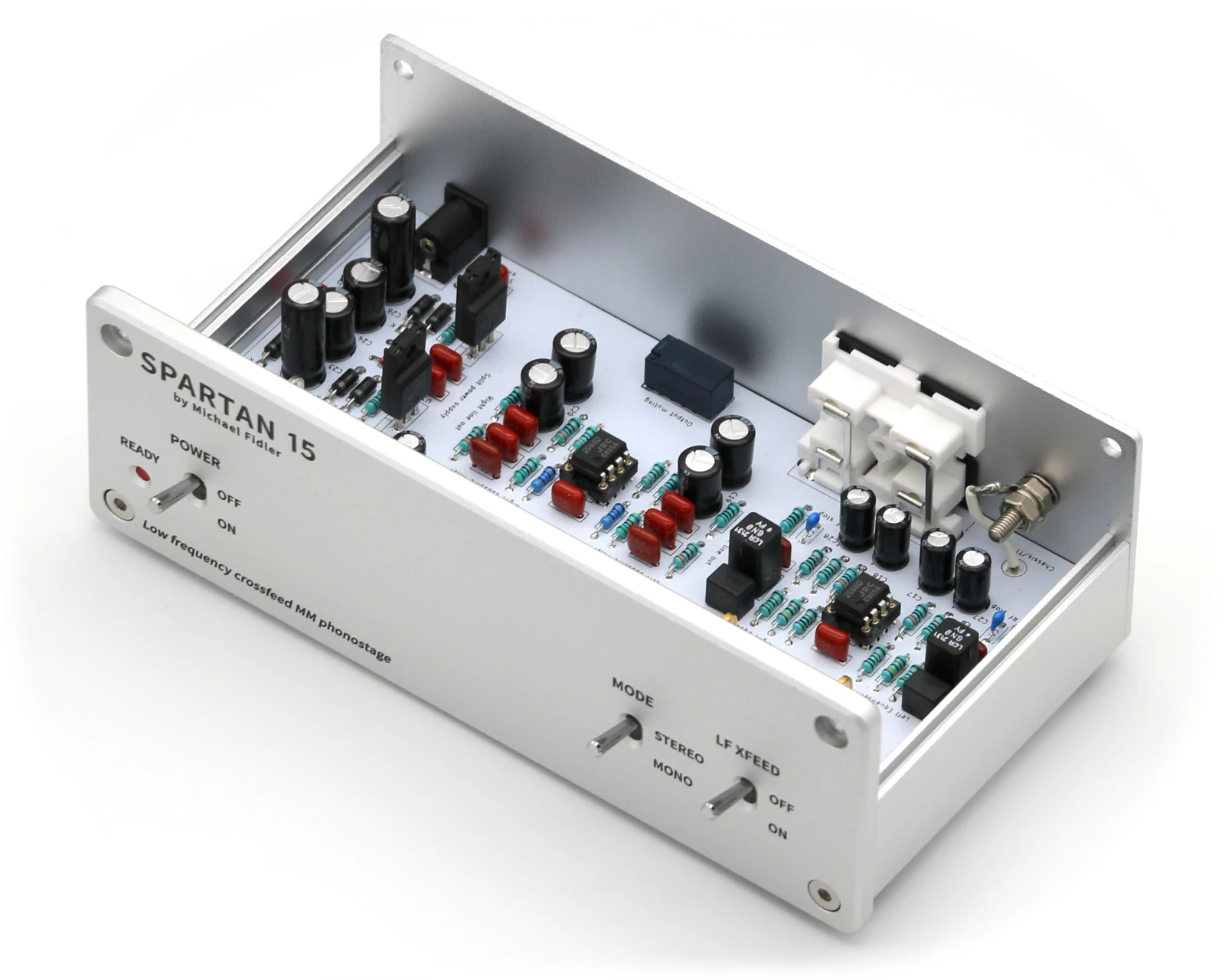
Open view with input and output networks
A slightly higher input impedance of 50kΩ helps to extend the frequency response of most moving-magnet cartridges, allowing some shortening of the input cables. Full DC decoupling enables hot swapping of headshells without thuds or bangs on the output. The input capacitance of 120pF will match well with almost all HiFi cartridges currently on the market and is also integrated into an effective RF filter that keeps digital and switching hash out of the music without any unwanted cellphone 'notifications' butting in at irregular intervals. An output impedance of 100Ω maintains healthy levels, keeping insertion loss into a typical 10kΩ line load below 1%.
The subsonic filter, set at 22Hz, heavily attenuates the worst surface disturbances in the 10Hz region by by 10 times (20dB), while low frequency crossfeed (LF X-Feed) helps reduce 'road noise' on stereo pressings by a very noticeable 10dB (3 times) at 50Hz, restraining low frequency overload in loudspeakers and corresponding distortion. The split power supply, with ±17V rails for an extra boost over the previous and more common ±15V, has a low standby consumption of just a fifth of a Watt and only 2W when operating at full steam.
Precision RIAA
To pack all the frequencies of recorded sound into a reasonably narrow groove, without too much surface noise, low frequencies have to be reduced and high frequencies have to be boosted when discs are cut according to the RIAA equalisation curve. On playback this curve has be accurately inverted by the phonostage, by doing the exact opposite and boosting bass frequencies while attenuating the treble response, recreating the original balance.
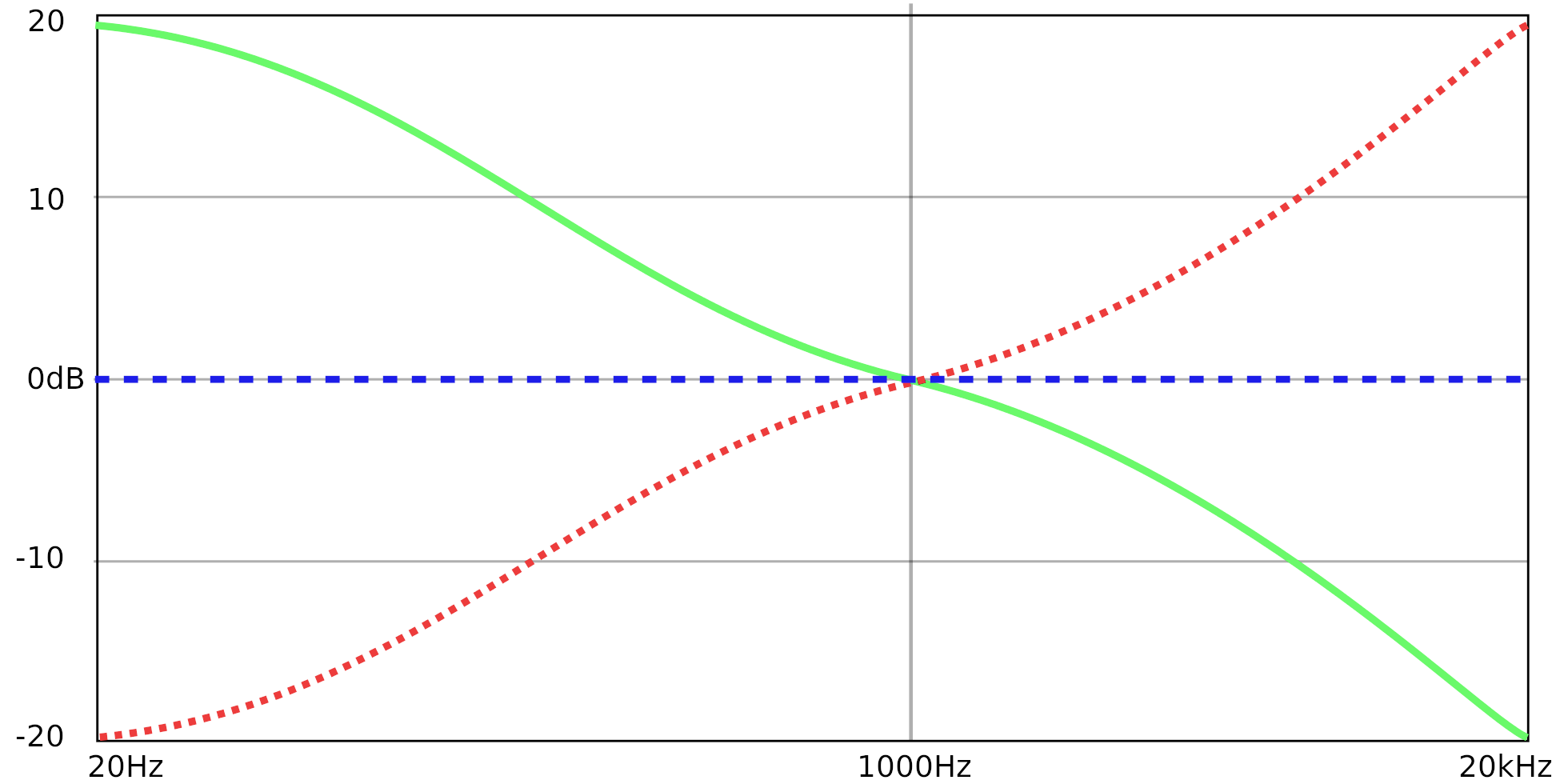
RIAA recording (red), playback (green), and sum (blue) curves
However, the final balance can only be as good as the equalisation accuracy of the phonostage, which is important as the RIAA curve has two turnover points in the midrange at 2122Hz and 500Hz where hearing is very sensitive. The vast majority of phonostages use low-cost 5% tolerance equalisation capacitors, creating ±0.5dB of error which can easily colour the sound in the midrange. The error also affect the stereo balance, due to tolerance differences between each channel. Most cartridges, on the other hand, have a very flat response in this critical range which then makes the phonostage the weakest link in the signal chain.
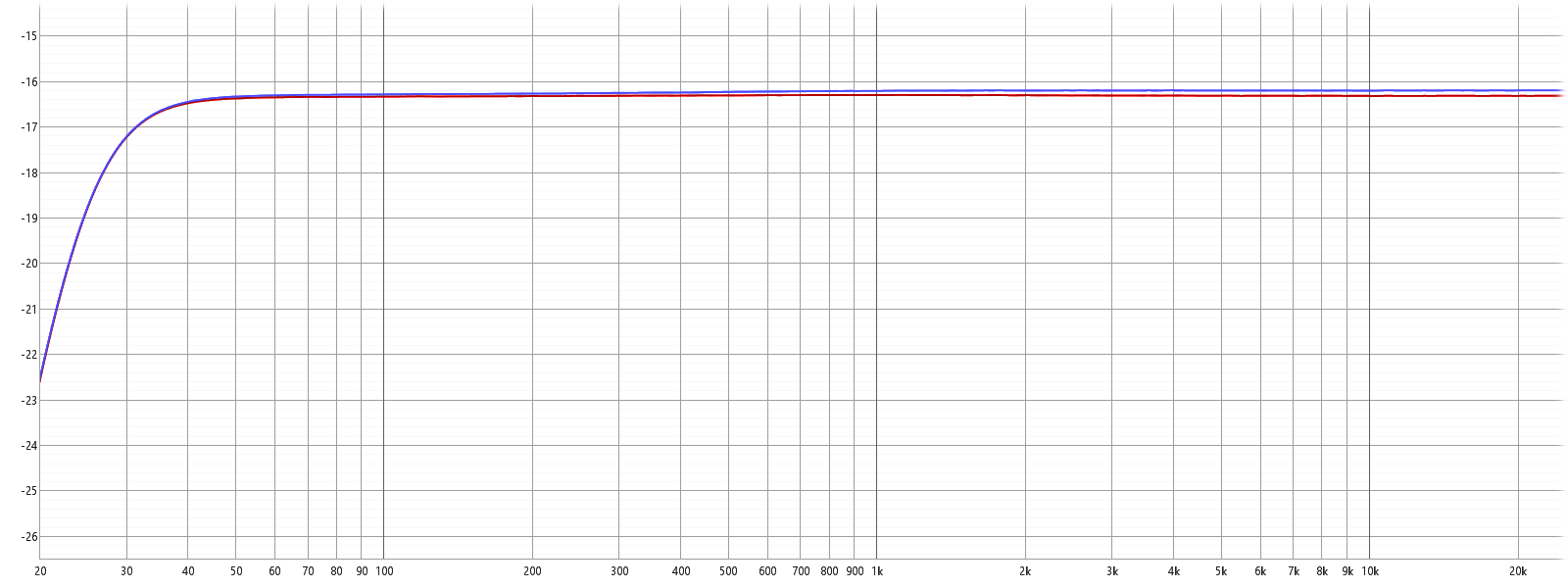
Typical measured RIAA response
The SPARTAN 15 shrinks this error down to a maximum of ±0.1dB, by using 1% tolerance polypropylene and polystyrene film capacitors in a precisely calculated RIAA network, generating zero audible colouration and much more constant stereo imaging that doesn't shift around as frequency changes. Such parts certainly aren't cheap, but consistently lead to a ruler-flat response, as shown above, that translates into a far more tonally transparent and faithful sound, so you hear the music exactly as it was mastered onto the record.
LF X-Feed
Because the RIAA curve boosts low frequencies on playback, most of the noise on vinyl exists in the lower frequencies, particularly on stereo recordings. Tiny surface warps, bearing noise, and little inconsistencies from the cutting process produce significantly more vertical (stereo difference) energy than lateral (stereo sum). This is easy to hear with headphones on and disappears as soon as the stereo channels are summed to mono. The record's grooves have much less vertical excursion available than lateral, so bass frequencies below about 200Hz have to be mixed down to mono when records are mastered to keep the cut groove from leaving the surface of the record itself.
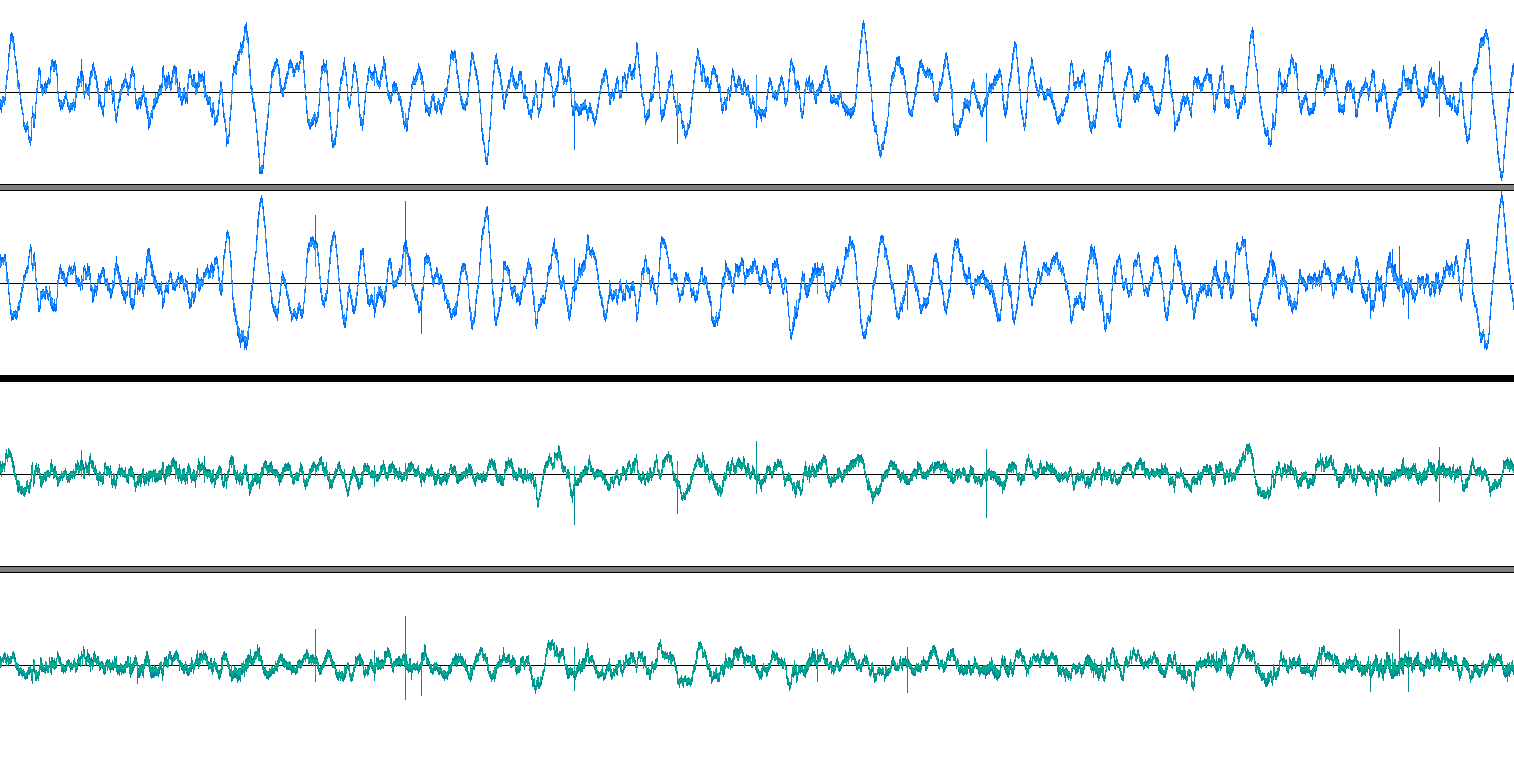
Normal (blue), and LF X-Feed (turquoise) stereo vinyl noise
The LF X-Feed feature blends the stereo channels to mono below 145Hz, cancelling much of the vertical noise seen above which is equal and opposite on each channel. This cuts down vinyl roar and rumble 3 times at 50Hz while protecting the stereo information recorded above 200Hz. Dropping the noise floor uncovers bass details that might otherwise have been lost, particularly useful for headphone listening. The defeatable briding network maintains channel separation at over 20dB at 1kHz when switched in and completely disappears from the signal path when switched off, to satisfy purists.
Subsonic filter
Powerful low-frequency disturbances are inherent to the vinyl medium, even on the most obsessively tuned turntable setups. Spurious energy below 20Hz caused by surface imperfections and mechanical noise, sometimes referred to as 'rumble', is inaudible on its own, but can severely distort audio as it passes through headphones, loudspeakers, and some types of amplifier. Subsonic noise is strongest around 10Hz, and leaches valuable headroom away from both amplifiers and loudspeakers. It's especially bad for ported designs where the unloaded drivers are quickly pushed to their limits at very moderate listening levels, visible movement of the cones destabilises the sound-stage and modulates the audio with 'fluttering' distortion.
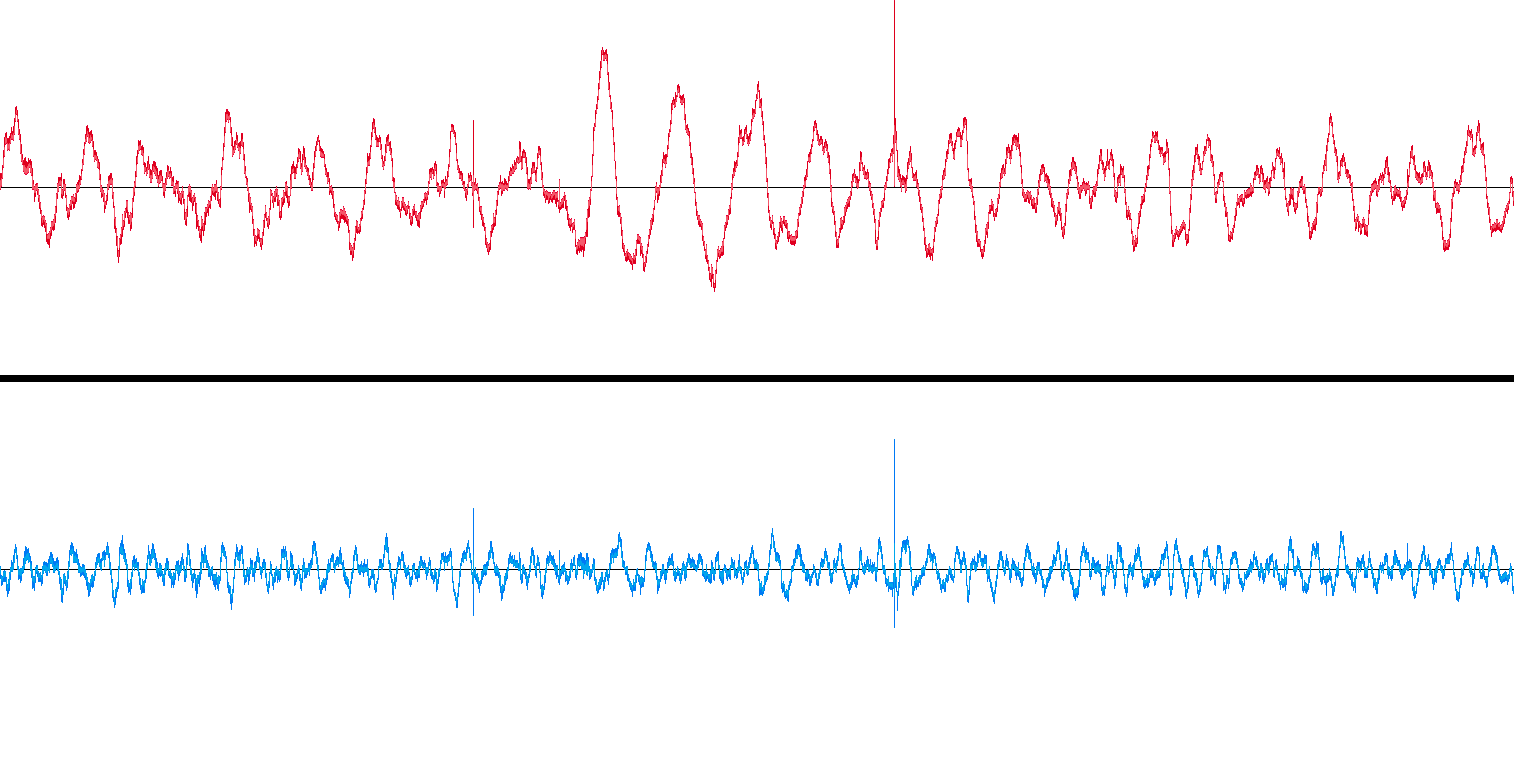
Unfiltered (red), and subsonic filtered (blue) vinyl noise
Subsonic energy should be removed from the signal path at the earliest opportunity with steep filter, with typical results shown above, to keep stereo imaging tight without any shimmering intermodulation. At least 14dB (5 times) of rejection at 10Hz is necessary to preclude trouble further down the signal chain, but importantly, the response down to 40Hz where the lowest practical recorded frequencies on vinyl lie must also be kept as flat and well-matched as possible. Creating such a filter is no easy task; many manufacturers use this challenge as an excuse not to implement the filter and cut costs, claiming that their flawed version of the prevention is worse than the cure.
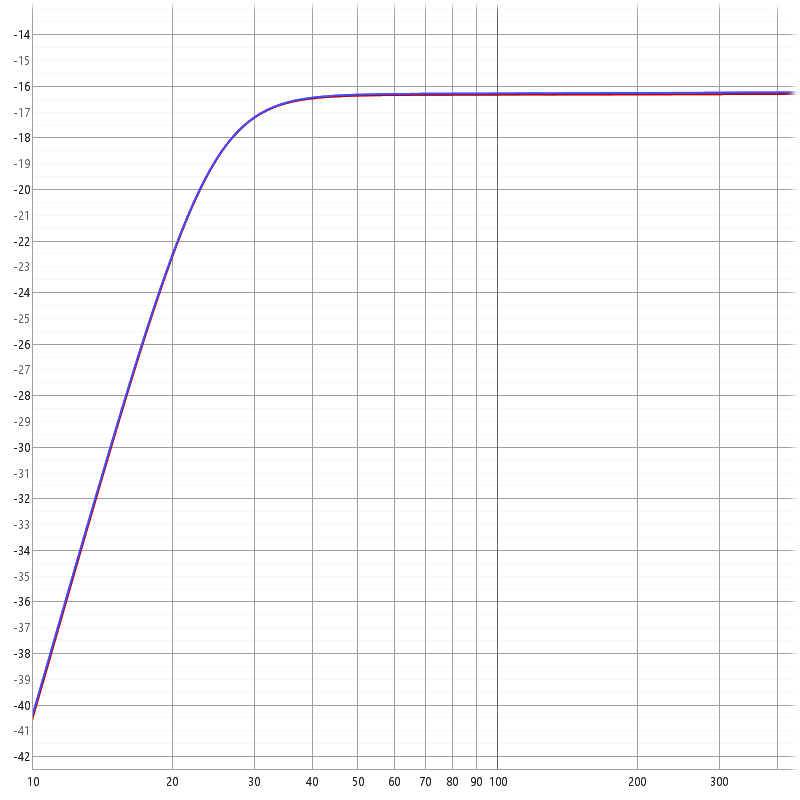
Steep measured subsonic response
This measured response shows how SPARTAN 15 retains its ±0.1dB RIAA accuracy and bass transparency down to 40Hz, before dramatically attenuating 10Hz disturbances by over 20dB (10 times). Distortion-free polypropylene film filter capacitors are hand-matched into 1% tolerance groups for each unit. Superb channel matching and filter flatness come a certainty, as evidenced by the red and blue stereo traces almost entirely overlapping each other! Better still, subsonics are filtered out before the final 11dB of gain in the double-stage design is applied, so the worst disturbances have no chance of stealing any of the final headroom away.
Mono switch
Mono discs and 78s from about 1950 onwards exhibit a marked improvement in quality if the left and right channels in a stereo setup are summed together. This is due to the stereo vertical plane of stylus movement exhibiting a generally higher level of noise and distortion artefacts, which are ignored by mono in the lateral plane. It's particularly apparent on older records, where the mono playback equipment of the day was insensitive to what happened vertically, and nobody cared so long as the groove stayed on the surface of the record. These discs don't make for great listening on modern stereo equipment without a true mono summing mode.

Mono (green), and stereo noise and distortion (red)
As can be seen in this waveform of mono audio alongside isolated stereo distortion artefacts and surface damage, these unwelcome intrusions can reach very annoying levels compared to the wanted audio. Luckily, the red waveform can be completely cancelled out by a mono switch that bridges the two channels together, removing this harsh and unpleasant component which straddles the stereo field and tugs the listener's attention away from the mono source in the centre. Heavily worn stereo pressings can also become more transparent, as the absence of distortion lets through little details that bring the magic back into the sound - no need for a dedicated mono cartridge here!
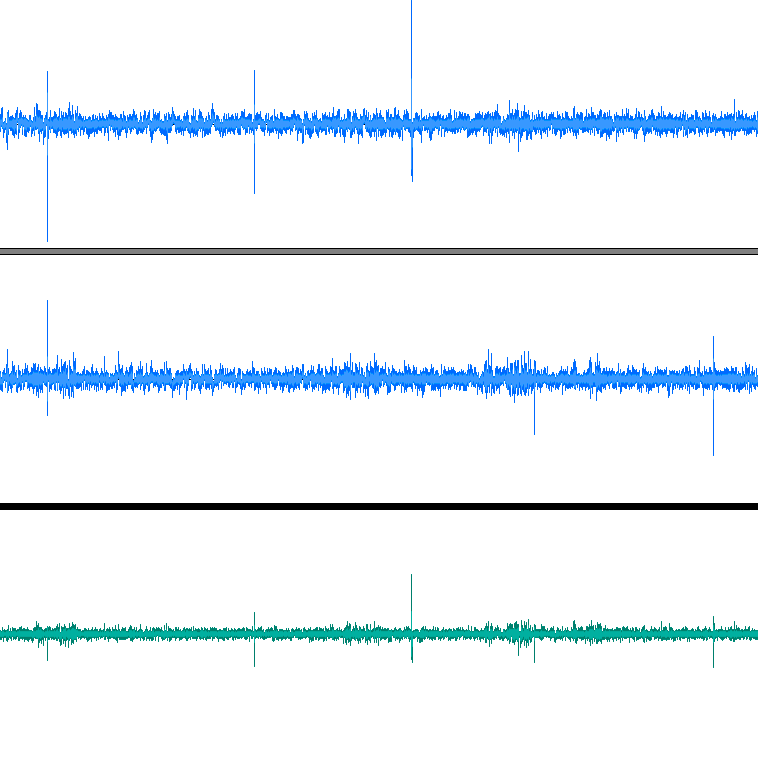
Stereo (blue), and mono (turquoise) vinyl noise
Surface clicks and 'vinyl roar' are also audibly diminished by switching to mono on old and new discs alike, as the above traces of stereo and mono groove noise show. The large vertical surface click on the left almost disappears. Clicks on the each side of the groove wall attack the listener distractingly from the edges of the soundstage, but are halved in amplitude and made much more innocuous when mixed down to mono. The constant surface noise also recedes away to half its value or less, exposing more of the music for a much more intimate connection with the original recording.
Linear power supply
So many contemporary designs use low-cost external switching power supplies to generate their internal DC rails. Unfortunately, these end up injecting audio frequency mains and switching noise into the reference ground, as they use small capacitors to couple their outputs back onto the mains so as to shunt away the RF energy inherent to their high-frequency operation. This is bad news for unbalanced connections where these unwanted currents will flow through the ground path in line connections and inevitably get mixed into the audio signal path, generating mains buzzes and switching hash. Typical 24V types also limit maximum output to 7V RMS or less.
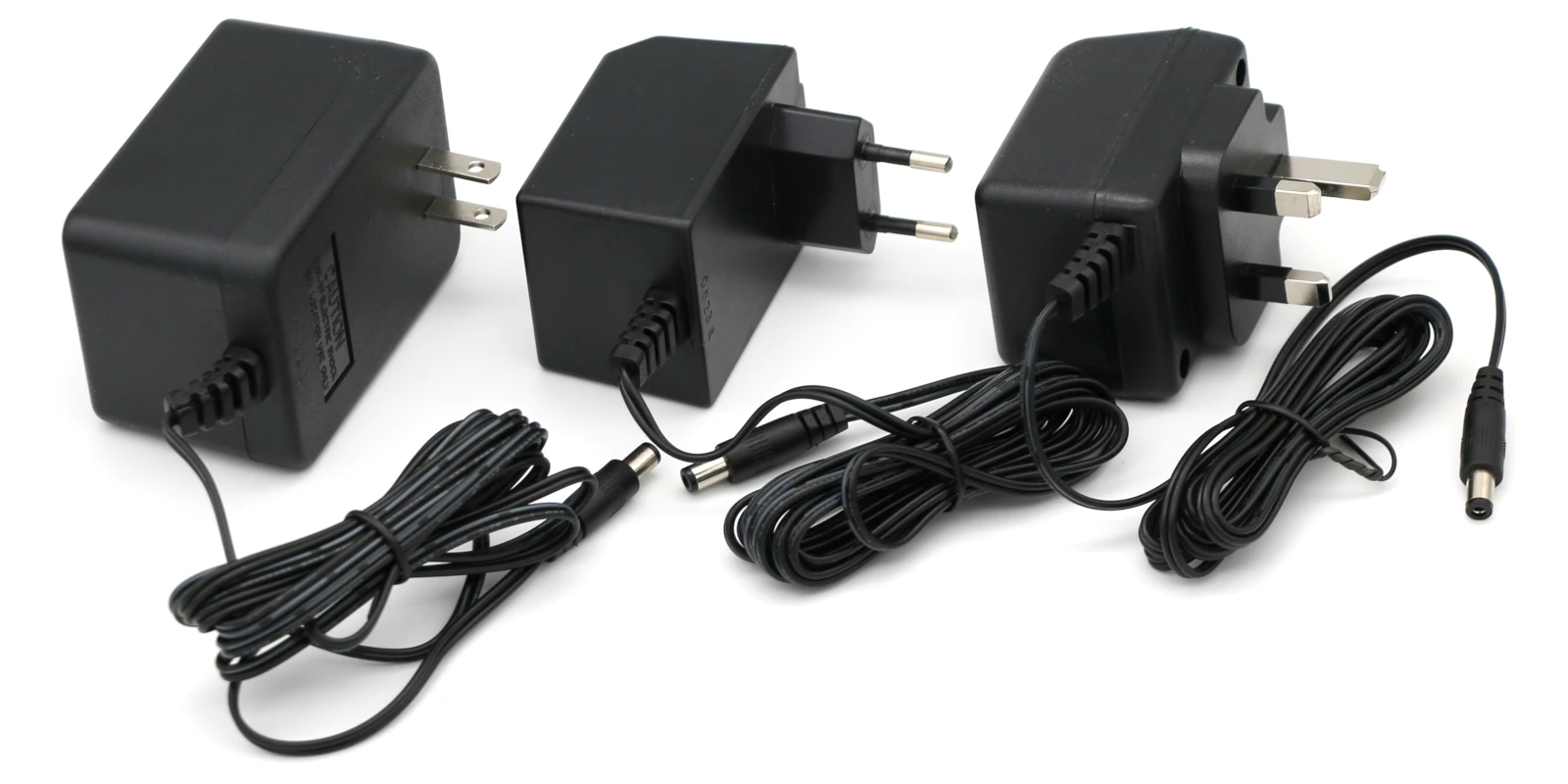
Energy efficient external transformers
Although it may look similar to switching wall-warts, the SPARTAN 15's external linear transformer power supply achieves true galvanic isolation from the mains and keeps its magnetic fields far away from the sensitive electronics. As the AC to DC conversion is done at the natural mains frequency, there are no sharp switching transients present either, resulting in a listening background free from contamination. Due to their state-of-the-art low-loss magnetics, greatly improved over the 'power vampires' of the 1990s, these weighty transformers consume less than 0.2W of power when not in use; not a low-cost solution but one that will pay for itself in the customers setup!

Linear power supply on PCB layout (left)
Double-digit headroom voltages are made available by the upgraded ±17V internal split power supply circuit that rectifies the 9VAC input into two separate rails which are then precisely regulated using linear ICs with external voltage reference diodes. Using the split rail technique with positive and negative voltages keeps non-linear amplifier power currents out of the signal path where they cause distortion in many single rail designs. Having the negative rail also removes the need for rail-generated DC bias voltages in the signal path which put stress on electrolytic capacitors and can result in DC leakage currents on the inputs and outputs - no clicks or pops when switching inputs, or nasty DC currents running through cartridges.
Reviews
Marc Henshall at Sound Matters received requests from his subscribers to investigate the company's phonostages, and reviewed the SPARTAN 15 just after it was officially released in November 2023.

The first thing that struck me about the Spartan 15 was just how quiet it is when idle; clearly, Michael’s two-stage amplification design and choice of components are paying off from the very start. On firing up a number of very familiar records, I was equally impressed with the playback performance. Transients are sharp, fast, and incredibly clean, bringing a sense of confidence to the overall presentation. The clarity in the low-mids, in particular, is exemplary, allowing me to hear more precise and clean bass notes compared to much of the competition. I would go as far as saying this is the most neutral-sounding phono stage I’ve heard; it really does simply get out of the way!
Marc's video review of the SPARTAN 15
In addition to the beautiful transparency, the Spartan 15’s very low noise floor did reveal additional details (something many audiophiles would describe as a “very black background”). I noticed extra clarity on reverb trails, along with more subtle details during quieter moments on my records. If you’re looking for the most neutral-sounding MM phono stage in the sub £500/$500 price bracket – you owe it to yourself to test-drive a Spartan 15 — particularly if you own a large collection of vintage mono records.
Marc Henshall, Sound Matters
Nipper Varney already had a SPARTAN 10 from 2021, so the SPARTAN 15 was included in one review as part of a comparison published on Audio Appraisal in April 2023.

This is a direct replacement of the 10. From the outside it looks basically the same, except to say smartened up with a more nicely finished and thicker front panel featuring bevelled edges and recessed screw heads and power light. The appearance compared to the original I saw with ‘DEMO” scratched into the front is night and day better. The product has come a long way in just a year and very much has the feel and appearance of a high quality product. The features also seem identical with rumble filter, switchable low frequency crossfeed for improved bass, and mono switch. Inside, though, I am told it is 95% different. This scares me as the Spartan 10 is so good – if you have struck gold, why restart from scratch?
On balance their performance is not dissimilar – which is excellent news given how incredibly high the 10 had set the bar, a huge relief! In my original review of the 10, when comparing it with the top of the range ProJect PhonoBox RS I noted the 10 was “sharper, faster, cleaner and more neutral, with clearer detail. The sound is closer to the digital version reference, more accurate and less coloured. The bass is noticeably tighter and the treble cleaner and brighter, creating a bigger, more expansive sound stage. There is a more clearly defined separation of instruments” By comparison to the 10 the 15 has all these attributes, but with a slightly fuller, enriched tone (though not as much as the 5) and the mids are a little more to the fore.
Three day’s break over Easter and I listen to the 15 again with fresh ears. Again the sound blows me away with it’s clear, self confident presentation. I would be absolutely delighted to have the 15 in my system for many years of pleasure without wondering if there was anything better out there, that I might be missing something. It is an “end game” phono stage and I am delighted and relieved that the 15 isn’t a flop after the greatness which was the 10, that the 10 wasn’t just a one hit wonder.
Nipper Varney, Audio Appraisal
Customer reviews
Sean took a leap of faith and ordered a SPARTAN 15 to the USA to see if he could improve his vinyl setup...
Just received the phono preamp. Right away. Louder, so much louder. Keeping the volume at the same level, much louder.
Louder is probably relatively easy for engineers, but louder without increasing noise floor, distortion, pops and crackles etc is another deal. Not only is it louder but the hum and other associated noises from the record and turntable are much lower.
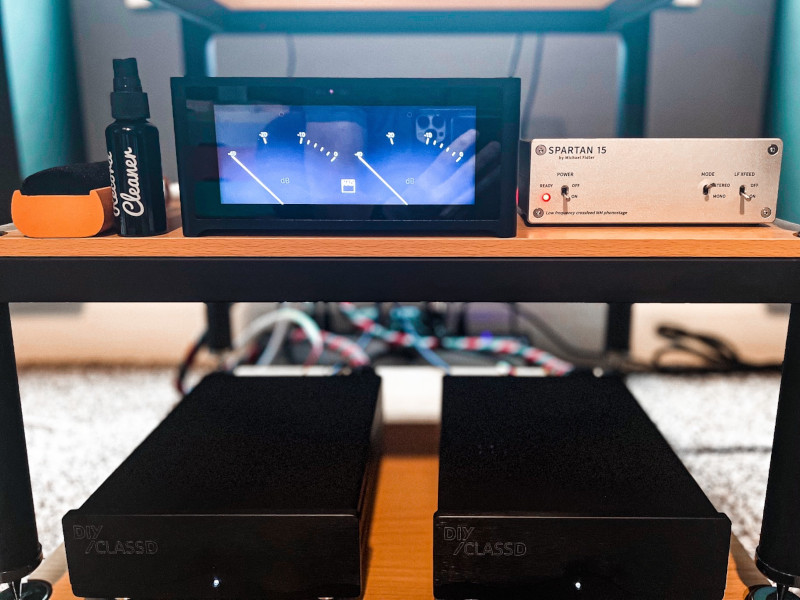
Sean's SPARTAN 15
I was a very skeptical, CD era guy and I am not saying I am now 100% vinyl guy now but I am surprised at the upgrade. I really am.
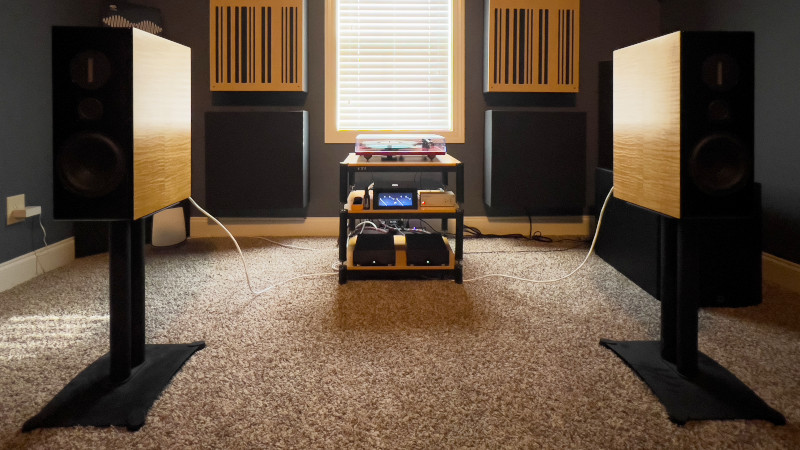
Sean's HiFi system
Regardless, well done sir, well done.
Sean, USA
Lee bought one of the first batch of SPARTAN 15s...
Just wanted to tell you how much I’m enjoying the Spartan 15. The dynamics and stereo imaging are superb.
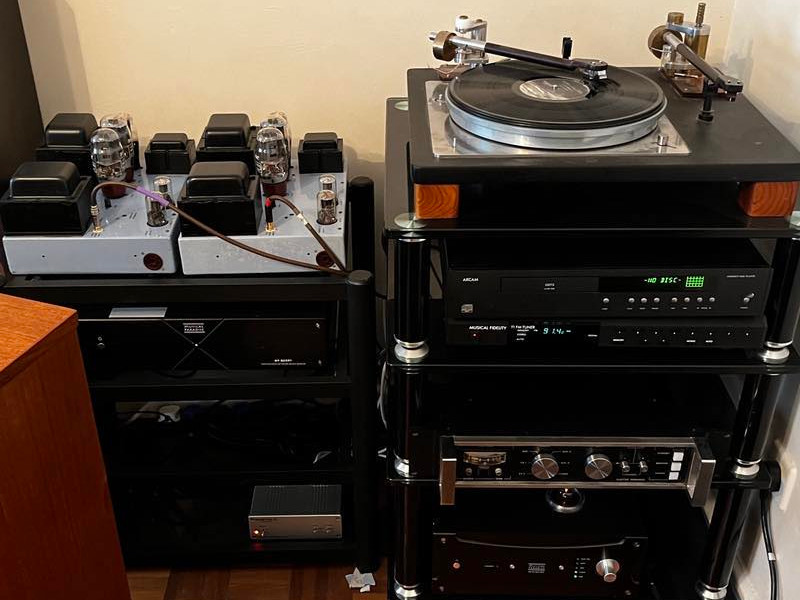
Lee's system
I use a strain gauge system which I think is pretty superlative but this more than stands up to it. It manages to pull out so much detail but is not wearing in any way.
I’ve been upgrading my system over the past couple of years and this is the icing on the cake.
Lee, London

